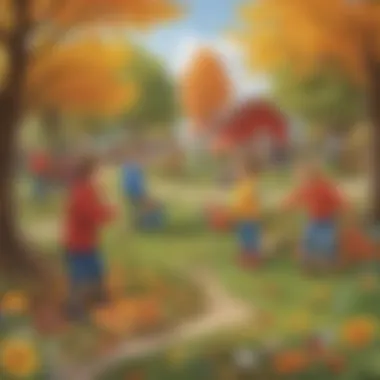Engaging Seasons Lesson Plan for Preschoolers


Intro
Seasons are all around us, transforming the world we see each day. For preschool learners, understanding these changes is not only fascinating but also fundamental to their grasp of nature and the environment. With leaves turning colors and snow appearing, children’s curiosity can be piqued by the sights and smells of different times of year. Teaching them about seasons engages their senses and encourages exploration.
This lesson plan aims to open young minds to the cyclical nature of seasons. It supports preschool educators, parents, and caregivers in making learning both fun and meaningful. Through hands-on activities, storytelling, and engaging discussions, children can explore each season's unique characteristics while developing essential cognitive skills.
In this guide, we’ll take a step-by-step look at how to effectively teach preschoolers about the seasons. By integrating interactive approaches and encouraging sensory experiences, we will cultivate their appreciation for the natural world.
Science Fun Facts
Children love discovering intriguing facts about the world. Here are a few captivating things about the seasons that might just spark their interest:
- Why Do Leaves Change Color? Leaves contain chlorophyll, which is green. In autumn, as daylight gets shorter, chlorophyll breaks down, revealing the vibrant reds, oranges, and yellows.
- Snowflakes are Unique! Each snowflake is different because they form under varying conditions of temperature and humidity. No two snowflakes are exactly alike.
- Spring Brings Baby Animals. Many animals give birth in spring, taking advantage of the warmer weather and abundant food.
- Summer Days are Longer. In summer, the Earth tilts towards the sun, making days longer and ensuring plenty of sunlight for plants and playtime.
"The beauty of nature is evident in the changing seasons; each one tells its own story."
Explore the Seasons
Through activities, children can explore various concepts related to seasons. Each activity encourages interaction and sensory engagement:
Interactive Learning Tools
- Nature Walks: Take children on a walk to observe seasonal changes. Encourage them to collect leaves, flowers, or even pinecones to examine later.
- Storytime Sessions: Read stories that highlight seasonal changes. Books that focus on spring growth, summer adventures, autumn harvest, and winter warmth can capture their imagination.
Real-Life Applications
- Discuss how seasons impact our daily lives, like choosing what to wear or what food is available during the year. This makes the learning personal and relatable.
Creative Activities
To further enrich their understanding, here are engaging activities:
- Art Projects: Let children create art representing different seasons using crafts like finger painting or collage with natural materials.
- Seasonal Songs: Introduce songs that celebrate the seasons, combining music with movement. Sing about falling leaves in autumn or sunshine in summer.
Epilogue
As children explore the concept of seasons, they will learn to appreciate the beauty around them. Each season represents a cycle, offering opportunities for growth, change, and wonder. By adopting various instructional techniques, we create an enriching environment for preschool learners where curiosity and creativity flourish. Through this comprehensive lesson plan, we’re not just teaching about seasons; we’re planting seeds of knowledge that will grow along with them.
Prelude to Seasons
Understanding the seasons is essential for preschool learners, as it introduces them to the regular patterns of nature and the environment around them. Each season offers different experiences and observations, shaping children's perceptions of their surroundings and encouraging them to make connections between weather, plants, and animals. When children grasp the concept of seasons, they learn not just about the changing weather, but also about the cycles of life that surround them. This foundational knowledge fosters curiosity and respect for nature, which is crucial in their growth and education.
Defining Seasons
Seasons can be defined as the division of the year marked by notable changes in weather and daylight. Most climates observe four distinct seasons: spring, summer, autumn, and winter. Each season brings with it unique characteristics and experiences:
- Spring is known for its warmth and the blossoming of flowers, signaling new life across the landscape.
- Summer often showcases longer days filled with bright sunshine, which enables outdoor activities and vibrant growth.
- Autumn, or fall, presents a time of transition, as trees shed their leaves and days begin to shorten.
- Lastly, winter is marked by its chill, often bringing snow and a period of rest for nature.
In preschool, understanding these definitions is more than learning names; kids engage with these concepts through play, exploration, and observation in their immediate environments.
Importance of Understanding Seasons
Grasping the concept of seasons is vital for preschoolers for several reasons:
- Cognitive Development: Children learn to categorize and identify physical changes in their surroundings, helping them develop critical thinking and observational skills. They can distinguish between hot and cold, dry and wet, and notice how these conditions affect living things.
- Emotional Awareness: Seasons also relate closely to feelings. For example, the excitement of spring may bring joy, while the quiet nature of winter can invoke introspection. This awareness helps children articulate their emotions and recognize that changes in the environment can affect how they feel.
- Environment Connection: When children learn about seasons, they start forming a connection with their environment. This interconnectedness can encourage stewardship and responsibility toward nature.
"Teaching young children about seasons is a way to open up a dialogue about nature and life cycles, reinforcing the idea that change is a natural part of growth."
Through interactive discussion and sensory exploration, educators can deepen children's understanding and appreciation of the world, laying a foundation for lifelong learning.
Learning Objectives
Understanding the learning objectives for preschool learners concerning the concept of seasons is a crucial component of any educational plan. These objectives offer foundational guidelines for educators, parents, and caregivers, helping to shape the learning experiences suitable for young children. Focusing on specific cognitive, emotional, and physical aspects can maximize the effects of the teaching methods employed, ensuring each child not only learns about seasons but also develops holistically.
Cognitive Goals
Cognitive goals concentrate on enhancing the intellectual capacities of preschool children. When discussing seasons, the aim is to stimulate curiosity and critical thinking. For instance, children might be asked to observe how trees change from spring blossoms to autumn leaves. This kind of observation helps them grasp concepts like change and transformation. By using tools like picture cards or stories, educators can facilitate discussions about different seasons and associated weather conditions.


- Key Points:
- Promotes analytical skills through observation.
- Enhances vocabulary related to nature and weather.
- Supports memory recall by learning about seasonal activities.
In doing so, children begin to recognize patterns, enhancing their overall cognitive development. This foundational understanding sets the stage for more complex environmental science topics later on.
Emotional Development
Emotional development is equally as important as cognitive development. Learning about seasons encourages children to connect with nature and express their feelings about changes in the environment. For instance, during autumn, children can collect colorful leaves, and discuss how they feel seeing the trees evolving. Such activities create a deep emotional bond with nature.
- Benefits:
- Fosters empathy through understanding seasonal animal behaviors.
- Encourages expression of feelings regarding weather changes, like excitement for snow or sadness when trees shed leaves.
- Builds resilience by helping children understand the cyclical nature of life, including the cold and warmth of seasons.
By providing an emotionally safe environment for these discussions, children can learn to articulate their experiences and feelings, thus enhancing their emotional literacy.
Physical Engagement
Physical engagement offers hands-on experiences that solidify children’s knowledge about seasons. From planting seeds in spring to building snowmen in winter, these activities promote both motor skills and kinesthetic learning.
- Considerations:
- Outdoor activities can include nature walks, encouraging children to observe seasonal changes firsthand.
- Creative movement activities which could involve dancing like the wind or pretending to be snowflakes.
- Arts and crafts using natural materials collected during season-themed activities, enhancing fine motor skills.
Physical engagement not only helps solidify educational concepts but also promotes a healthy lifestyle, encouraging children to be active and engage with their environment meaningfully.
Seasonal Themes and Characteristics
Understanding the seasonal themes and characteristics is pivotal in grasping the full essence of nature’s rhythmic cycle. For preschool learners, these themes present an opportunity to connect with the world around them in meaningful ways. Each season not only changes the scenery but also impacts the behavior of plants, animals, and even the weather we experience. By focusing on the distinct qualities of each season, educators can help children foster curiosity and a deeper appreciation for their environment.
Spring: Renewal and Growth
Spring breathes new life into the world. This season is often seen as a time for renewal; trees begin to show buds, flowers bloom, and animals wake from their winter slumber. For preschoolers, spring represents transformation. Through hands-on activities like planting seeds, children can witness growth first-hand. They can observe how a tiny seed turns into a plant, making the concept of growth tangible.
Additionally, stories like "The Very Hungry Caterpillar" by Eric Carle can underscore spring’s themes of change and development as children watch a caterpillar become a butterfly. These experiences not only nourish cognitive growth but also nurture a sense of wonder and respect for life’s processes.
Summer: Energy and Activity
As spring gives way to summer, the heat prompts outdoor adventures and energetic play. This season is characterized by bright, sunny days that beckon learners to engage actively. Organizing water play or nature scavenger hunts allows children to explore their environment in an engaging and exciting way.
Summer themes can be integrated into art projects too; for instance, using vibrant colors to depict beaches or summer fruits. Activities highlighting the importance of hydration and sun safety also weave valuable life lessons into the fun, promoting an energetic lifestyle that is balanced with responsibility.
Autumn: Transition and Reflection
When leaves turn golden and fall to the ground, it's a clear sign that autumn has arrived. This season teaches children about change, marking a transition that mirrors their own growth and learning. Collecting leaves, pressing them between pages, or creating leaf rubbings are imaginative and tactile ways for preschoolers to connect with nature.
Storytelling can also play a profound role; books that discuss themes of thankfulness, like "The Giving Tree" by Shel Silverstein, encourage reflections on giving and gratitude during the fall festivities. Engaging children in discussions about what they are thankful for fosters emotional growth and enhances their understanding of community values.
Winter: Rest and Preparation
Winter brings a frosty stillness, and it’s a season often associated with rest and preparation. While plants may seem lifeless, underneath the snow, they are gearing up for the growth of spring. Educators can use this quiet time to teach children about hibernation or dormancy in nature.
Winter activities could include crafting snowflakes or reading stories that celebrate winter holidays, such as "The Snowman" by Raymond Briggs, which can spark imaginative discussions about winter traditions. These lessons teach children the importance of rest and preparation for future growth, all wrapped up in engaging, interactive experiences that resonate with their daily lives.
"Each season has its own magic, and for young minds, understanding this creates a lifetime of curiosity."
The goal here is not just to observe but to become active participants in the cycle of seasons. This connection to nature aligns with their intrinsic desire to explore, creating a foundation for lifelong learning about the world that surrounds them.
Interactive Activities
Interactive activities play a crucial role in a lesson plan centered on seasons for preschool learners. They do not just make the learning process enjoyable; they also facilitate deeper understanding and retention of concepts. By engaging children through hands-on experiences, educators can tap into diverse learning styles prevalent in young learners. This section highlights specific activities that embody the essence of seasonal exploration.
Seasonal Arts and Crafts
Arts and crafts provide an excellent avenue for preschoolers to express themselves while connecting with the seasons. Think about how a child can create colorful leaves from construction paper during autumn or design sun catchers that mimic the bright sunlight of summer. Each craft can be tied to a specific season and its unique traits.
- Benefits:


- Fine motor skills: Cutting, gluing, and painting enhance dexterity.
- Creativity: Artistic expression naturally encourages imagination.
- Understanding seasons: Crafts reinforce lessons about the characteristics of each season.
To facilitate this, teachers might set up crafting stations that focus on one season at a time, allowing the children to cycle through various seasonal themes. This not only keeps the interest alive but also establishes a strong visual and tactile connection to the concepts taught.
Nature Walks and Observations
One of the most engaging methods to teach preschoolers about seasons is through nature walks. Stepping outside, feeling the wind, and observing changes in the environment provides real-world context. Children can collect items such as leaves, flowers, or even rocks and discuss how they differ across each season.
- Considerations:
- Safety first: Always ensure the route is safe for little legs.
- Guided discussions: Encouraging children to share their observations can foster dialogue and critical thinking.
- Recording findings: Providing simple notebooks allows kids to sketch or jot down what they see.
By utilizing a keen observational approach, preschoolers grow to appreciate nature's cycles firsthand, making lessons memorable.
Storytime and Literature
Integrating storytime into seasonal learning can envelop children in the wonders of each season through narratives. Whether it’s reading about a hibernating bear in winter or a blossoming garden in spring, literature anchors comprehension in relatable scenarios.
- Why it's effective:
- Language development: Storytime enriches vocabulary and language skills.
- Emotional connection: Stories often reflect feelings tied to seasons, aiding emotional growth.
- Cultural insights: Many stories introduce cultural celebrations linked to seasons, broadening perspectives.
To enhance this experience, educators might consider presenting stories with corresponding visuals or puppets. This not only captivates the children's attention but also helps solidify their understanding of the content discussed.
"Interactive activities create a bridge between theory and practice, helping preschoolers anchor abstract concepts in tangible experiences."
Incorporating these interactive activities will boost engagement among young learners and facilitate a holistic understanding of the seasons' impact on their world.
Incorporating Science Concepts
Understanding the seasons is more than just recognizing four distinct times of the year. By delving into scientific concepts, preschool learners can connect with the world around them in meaningful ways. Incorporating science in lessons about seasons fosters curiosity, enhances observational skills, and encourages a love for nature. This approach offers children a rich blend of knowledge and experience, helping them grasp how various elements of the environment interlink.
Weather Patterns and Seasons
Weather is a vital aspect of each season. Teaching preschoolers about how weather changes can lead to exciting discoveries. For instance, children can observe rainy days in spring, the scorching sunshine of summer, the crisp air of autumn, and the snowy wonderland of winter. Each observation provides a platform to discuss concepts such as temperature changes, precipitation, and seasonal phenomena.
"Children who observe the weather engage their senses, which deepens their understanding of the natural world."
To make this engaging:
- Weather Journal: Encourage children to keep a simple weather journal. They can draw pictures or use stickers to represent sunny, rainy, or snowy days.
- Weather Games: Play games that involve identifying weather types, like a matching game with symbols for sun, rain, snow, and clouds.
Plant Growth and Seasons
Plants exhibit dramatic transformations across different seasons. By observing how plants behave in spring through blooming, in summer through lushness, in autumn as leaves change colors, and in winter when they often go dormant, children realize that life is cyclical.
Utilizing simple activities can help explain plant seasons:
- Seed Planting: Have preschoolers plant seeds in pots during spring and monitor their growth. This hands-on experience offers a direct connection to the concepts they are learning.
- Nature Walks: Take kids on nature walks where they can observe various plants. Provide them with magnifying glasses to inspect new buds or autumn leaves closely.
Animal Behaviors During Seasons
The animal kingdom reacts to seasonal changes in fascinating ways. Teaching children about migration, hibernation, and breeding seasons can spark their imaginations. For example, they might learn that some birds fly south during winter, while others prepare their nests in spring.
To deepen understanding, use engaging storyboards or role-playing activities:
- Role Play: Encourage kids to act out the behaviors of animals in different seasons, whether pretending to hibernate like bears or migrate like geese.
- Animal Observation: Watch animal documentaries designed for preschoolers, highlighting different animals and their seasonal routines. Discuss what they observe in class afterward.
Incorporating these scientific concepts not only provides a robust framework for understanding seasons but also promotes critical thinking, observation, and environmental stewardship among young learners.
Assessment Methods
Understanding how to assess children's grasp of seasonal concepts is crucial. Assessment methods are the means by which educators can gauge the effectiveness of their teaching strategies and the extent to which preschool learners have internalized knowledge about the seasons. By using various assessment techniques, teachers can adapt the lesson plan to better fit the needs of their students. It's not merely about assigning a grade, it's about gaining insights into each child's understanding and enthusiasm towards learning about the seasons.
Consider the following benefits of implementing effective assessment methods:
- Tailoring Instruction: Through assessments, educators can identify which areas need reinforcement, allowing them to refine lesson plans to address specific knowledge gaps.
- Fostering Confidence: Engaging students in assessments can boost their self-esteem as they showcase their understanding in a supportive environment, ultimately making learning more enjoyable.
- Promoting Parental Engagement: Assessment results can open up discussions with parents, providing them an avenue to reinforce lessons at home.


Ultimately, the goal is to create an enriching learning atmosphere where children can thrive through feedback and iterative learning.
Observational Assessment
Observational assessment is one of the most organic ways to watch children learn. It involves teachers participating in activities alongside the kids, quietly noting their interactions, engagement levels, and responses to various tasks. This approach provides immediate insight into how well children comprehend the changing seasons.
For example, while on a nature walk, a teacher may observe a child noticing the different colors of leaves. This can lead to an informal conversation about autumn and the cycle of life. The notes gathered can help frame a more nuanced understanding of each child's individual learning style.
"Every child is a different kind of flower, and all together make this world a beautiful garden." – Unknown
Interactive Quizzes and Games
Interactive quizzes and games serve as a fun and engaging method for assessing what children have learned about the seasons. These activities help solidify concepts in a non-threatening environment. This could involve matching games where kids identify various seasonal items.
- Examples include:
- Seasonal Bingo: Create bingo cards with images representing different seasons. As the teacher calls out items, children can mark their cards, allowing for visual learning while also checking comprehension.
- Guess the Season: Prepare a simple quiz where children must guess the season based on clues. For instance, the clue can describe a seasonal activity like "building a snowman" for winter.
These interactive methods celebrate children's successes, making assessments a joyous part of classroom culture.
Creative Presentations by Children
Encouraging children to showcase their learning through creative presentations acts as a powerful assessment tool. This method allows kids to express what they've learned about the seasons in ways that resonate with them personally, whether through art, storytelling, or even puppetry.
- Ideas for presentations could involve:
- Art Projects: Children can create collages representing their favorite season and explain their choices to the class.
- Seasonal Stories: Kids can narrate or dramatize seasonal changes, illustrating concepts of growth, hibernation, or migration, tying back to lessons.
It emphasizes not just their grasp of concepts but also their communication skills and creativity. Plus, witnessing their peers’ presentations can foster a collaborative spirit in the classroom.
Each of these assessment methods underlines the significance of a holistic understanding and appreciation of seasons, offering valuable insights into each child’s learning journey.
Parental Involvement
Parental involvement is a cornerstone of a successful educational experience, particularly for preschool learners. When parents engage in their child's learning process, it enhances not only the child's understanding but also strengthens the family bond. This engagement in understanding the seasons can help parents harness their child's curiosity about nature, fostering both learning and connection at home.
Engaging Parents in the Learning Process
To effectively engage parents, educators can encourage them to participate in activities that align with the seasonal themes being taught. For instance, when students are exploring spring, parents might take their children outside to look for budding flowers or even start a small garden together.
- Share Experiences: Encourage parents to share their own childhood experiences related to seasons. This could be the smell of fresh rain in spring, summer picnics, autumn leaves crunching, or winter snow days. These stories can spark joyful conversations and deepen a child's connection to what they're learning.
- Seasonal Journals: Parents can maintain a seasonal observation journal with their children, jotting down changes in nature they notice as the seasons shift. This not only builds writing skills but creates an avenue for discussing the natural world.
Engaging parents in such active, hands-on opportunities empowers them to take a meaningful role in their child’s educational journey while expanding their understanding of the importance of seasons.
Sharing Resources and Tips
Providing parents with accessible resources and practical tips can help bridge the learning at school and home.
- Resource Packs: Create packs that include activities, such as simple crafts related to each season or lists of books about seasons. Simple websites such as Wikipedia and Britannica can provide additional information that can help explain complex topics effectively.
- Weekly Updates: Send out weekly newsletters that outline what the children learned, contested the relevance of the concepts, and relevant seasonal activities that parents can do at home.
- Celebrate Together: Encourage parents to join seasonal celebrations—whether it’s a summer picnic or a fall harvest party. These events allow parents to bond with their children while simultaneously reinforcing the seasonal themes being learned in class.
"When parents take part in the learning process, they not only support their children's education but also build lasting memories and understanding that will carry through their entire lives."
Ultimately, parental involvement in learning about the seasons cultivates a richer educational environment for preschoolers. It plays a significant role in enhancing children's curiosity and understanding while fostering connections that extend beyond the classroom.
Ending
As we wrap up the exploration of seasons for preschool learners, the conclusion underscores how vital it is to foster an awareness of the natural world in young minds. Understanding seasons not only nurtures a curiosity about nature but also builds a solid foundation for future learning. Preschoolers, in their early years, are like sponges, soaking up knowledge from every experience. By engaging them in seasonal activities, we help them recognize changes in their environment, which can profoundly impact their overall development.
Reiterating the Significance of Seasonal Awareness
Seasonal awareness plays a key role in a child’s cognitive and emotional growth. When children learn about seasons, they start making connections between their daily experiences and the broader environment. For example, recognizing that flowers bloom in spring and leaves fall in autumn offers them a context for understanding life cycles.
Moreover, this awareness cultivates empathy towards living things. Children learn that winter is not just cold; it is a time where animals prepare for sleep or migration. This leads them to questions and discussions, fostering their critical thinking skills. It’s essential that preschoolers understand how seasons affect their surroundings, which in turn shapes how they perceive their place in the world.
Encouraging Lifelong Learning About Nature
Encouraging a lifelong love for nature starts at an early age. As children observe and discover seasonal changes, they develop habits of inquiry. This can extend beyond the curriculum and into their everyday lives, prompting them to ask questions, go on explorations, and share what they learn with family and friends.
Incorporating activities that connect with different seasons helps lay this groundwork. Simple acts like collecting autumn leaves or observing snowfall can spark a sense of wonder. These small experiences can grow into larger ambitions, such as environmental stewardship. We want to create an environment where curiosity thrives so that children not only learn about seasons but also carry these lessons forward. It’s about more than just recognizing spring; it’s inviting them to become lifelong learners who respect and cherish nature throughout their lives.
"To observe nature is to discover the threads that weave life together."
In summary, the significance of seasonal awareness and the encouragement of a love for nature are crucial elements of this lesson plan. They help children develop cognitively, emotionally, and socially, providing them with tools to navigate their world thoughtfully as they grow.







